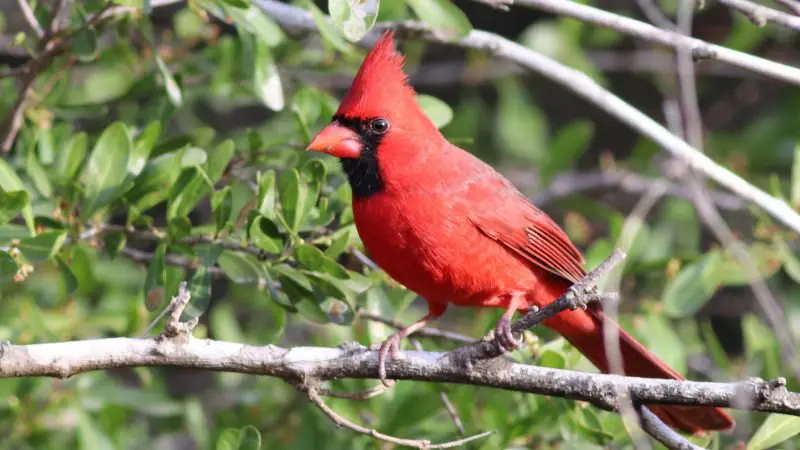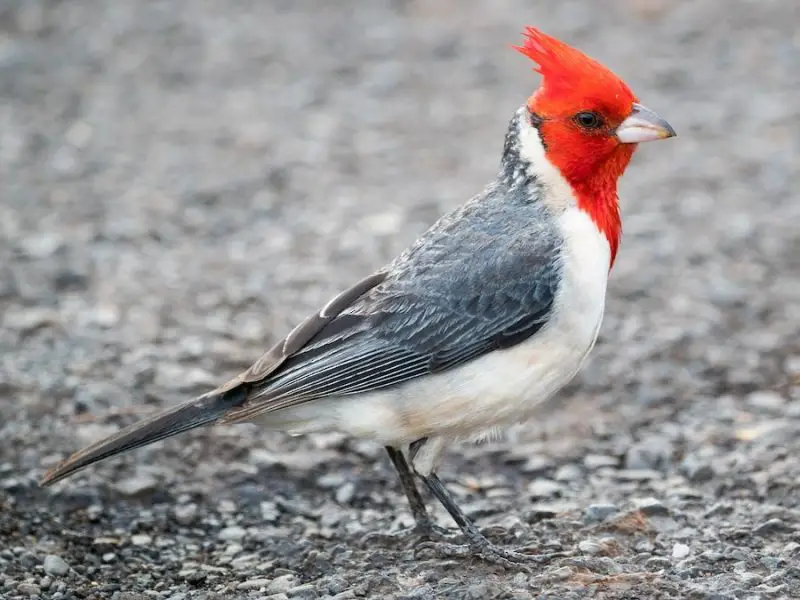Hawaii is home to a surprising variety of colorful birds, and among them are three striking species often referred to as cardinals. Though none are native to the islands, these birds have established themselves across multiple habitats, from city parks to coastal shrublands.
In this guide, you’ll discover the three main types of cardinals found in Hawaii: the Northern Cardinal, Red-crested Cardinal, and Yellow-billed Cardinal. Each has unique markings, behaviors, and histories tied to their introduction to the islands.
We’ll explore how to identify them, where to find them, and what makes each species special. With pictures and detailed tips, this is your go-to resource for spotting cardinals in Hawaii.
Different Types of Cardinals Found in Hawaii
Northern Cardinal (Cardinalis cardinalis)

The Northern Cardinal is one of the most iconic songbirds in North America and has become a familiar sight in Hawaii since its introduction in the late 1920s. Males are brilliantly colored with vibrant crimson plumage all over, contrasted by a black mask around the face that extends to the throat. Females, in contrast, are mostly warm brown with red tinges on the wings, crest, and tail. Both sexes have a distinctive, prominent crest and a thick orange-red beak, making them easy to identify even from a distance. They measure about 8 to 9 inches (20–23 cm) in length.
In Hawaii, Northern Cardinals are year-round residents and are commonly found in residential gardens, parks, dry lowland forests, and even urban areas. They are usually observed foraging on the ground or low shrubs, searching for seeds, grains, berries, and insects. Their feeding behavior is marked by their strong, cone-shaped bill that’s perfect for cracking seeds. While not particularly aggressive, males are known to be territorial and will often chase away intruders during breeding season.
Breeding in Hawaii follows a similar pattern to their native range. Males sing frequently to attract mates and defend nesting areas. Their song is a clear, whistled series of notes that often sounds like “cheer-cheer-cheer” or “birdy-birdy-birdy.” The female builds a cup-shaped nest in dense shrubs or trees using twigs, grasses, and leaves. Clutches typically contain 2 to 4 eggs, which she incubates for around 12–13 days. Males often help feed the chicks once they hatch.
A fun fact about the Northern Cardinal is that they are one of the few bird species in which both males and females sing. In Hawaiian landscapes, their melodic songs often stand out in the early morning hours. Although they are not native, they have adapted remarkably well to Hawaii’s environment and have become a beloved part of the local birdwatching scene.
Red-crested Cardinal (Paroaria coronata)

The Red-crested Cardinal is one of the most recognizable and charismatic birds in Hawaii. Native to South America, it was introduced to Hawaii in the 1930s and has since become a widespread and familiar presence, especially on Oʻahu, Kauaʻi, and the Big Island. This species is not a true cardinal but belongs to the tanager family. It is easily identified by its striking red head and crest, white belly, and soft gray wings and back. Adults measure around 7.5 inches (19 cm) in length.
These birds are highly social and often seen in pairs or small flocks foraging in open grassy areas, hotel gardens, public parks, and coastal scrublands. Their diet consists of seeds, fruits, flower petals, and small insects. They are opportunistic feeders and may approach humans for food, especially in tourist areas where they are accustomed to being fed. Red-crested Cardinals are curious and bold, making them popular among visitors and residents alike.
Breeding behavior typically occurs during the spring and summer months. The female builds a small nest in shrubs or trees, using plant fibers and twigs. She lays 2 to 3 eggs, which are incubated for about 12 days. Both parents participate in feeding the chicks once they hatch. Their vocalizations are soft and melodious, often heard as a series of clear, sweet whistles, quite distinct from the Northern Cardinal’s stronger song.
An interesting fact is that while this bird resembles a cardinal due to its red head and crest, its genetic lineage is closer to South American tanagers. It has adapted well to Hawaii’s mild climate and abundance of human-friendly habitats. Because of its beauty and gentle nature, the Red-crested Cardinal is frequently featured in Hawaiian postcards and tourism imagery, despite not being a native species.
Yellow-billed Cardinal (Paroaria capitata)

The Yellow-billed Cardinal is a lesser-known but visually striking species occasionally found in parts of Hawaii, particularly on the Big Island. Like the Red-crested Cardinal, it belongs to the tanager family and is native to South America. It is slightly smaller than its red-crested cousin, measuring around 6.5 inches (17 cm) in length. This bird is recognized by its bright red head (lacking a crest), stark white underparts, glossy black back and wings, and distinctive yellow bill, which sets it apart from other cardinal-like birds.
This species is less common and has a more limited range in Hawaii compared to the Northern and Red-crested Cardinals. It prefers areas with dense shrubs near water sources, agricultural lands, or quiet suburban zones. Yellow-billed Cardinals forage mostly on the ground, feeding on a mixture of seeds, berries, insects, and grains. They are usually seen in small groups, often moving quickly and quietly among low vegetation or along riverbanks.
Their nesting behavior is similar to that of their relatives. The female builds a compact nest low in shrubs or trees and lays a small clutch of 2 to 3 eggs. Both parents contribute to feeding the young, and like other Paroaria species, they tend to be devoted caregivers. Vocalizations are not as loud or musical as the Northern Cardinal’s but consist of soft chirps and squeaky calls.
A fun fact about the Yellow-billed Cardinal is that it is sometimes mistaken for a juvenile Red-crested Cardinal because of its similar red-and-white coloration. However, its yellow beak and lack of a crest are key identification points. Though it is not widespread, sightings of this elegant species are a treat for birdwatchers on the Big Island and add a touch of South American flair to Hawaii’s already diverse avifauna.
FAQs about Cardinals in Hawaii
What types of cardinals can be found in Hawaii?
Hawaii is home to three main types of cardinal-like birds: the Northern Cardinal (Cardinalis cardinalis), the Red-crested Cardinal (Paroaria coronata), and the Yellow-billed Cardinal (Paroaria capitata). All three species were introduced to the islands and are not native.
Are cardinals native to Hawaii?
No, none of the cardinal species found in Hawaii are native. They were introduced in the early to mid-20th century and have since adapted well to the Hawaiian environment.
Which cardinal is the most common in Hawaii?
The Red-crested Cardinal is the most widespread and frequently seen cardinal-like bird in Hawaii, especially in urban areas and parks. The Northern Cardinal is also quite common, while the Yellow-billed Cardinal is less frequently encountered.
How can I tell the difference between the Red-crested and Northern Cardinal?
The Red-crested Cardinal has a red head and crest, gray wings, and a white belly, while the Northern Cardinal male is entirely red with a black face mask. Female Northern Cardinals are brown with red highlights. Also, the Red-crested Cardinal belongs to the tanager family, not the true cardinal family.
Where can I see cardinals in Hawaii?
You can spot cardinals in public parks, gardens, residential areas, forests, and coastal scrublands across the main Hawaiian Islands, especially on Oʻahu, Kauaʻi, Maui, and the Big Island.
Do cardinals in Hawaii sing?
Yes! Both Northern Cardinals and Red-crested Cardinals sing. The Northern Cardinal’s song is loud and whistling, while the Red-crested Cardinal’s song is softer and more melodic. Interestingly, both male and female Northern Cardinals sing—a rare trait in songbirds.
What do cardinals eat in Hawaii?
Cardinals feed on a variety of foods including seeds, grains, fruits, flower petals, and insects. They are often seen foraging on the ground or in low shrubs. In tourist areas, they may even approach humans for food.
When is the breeding season for cardinals in Hawaii?
Cardinals in Hawaii typically breed during spring and summer, although the tropical climate can allow for extended or multiple breeding periods. They build nests in shrubs or trees and lay 2–4 eggs per clutch.
What is the rarest cardinal in Hawaii?
The Yellow-billed Cardinal is the least common among the three. It is mainly found on the Big Island and is often confused with juvenile Red-crested Cardinals due to its similar coloration.
Are cardinals protected in Hawaii?
While they are not native, cardinals are protected under general bird protection laws, and it is illegal to harm or capture them. They are appreciated by residents and tourists alike for their color and song.






